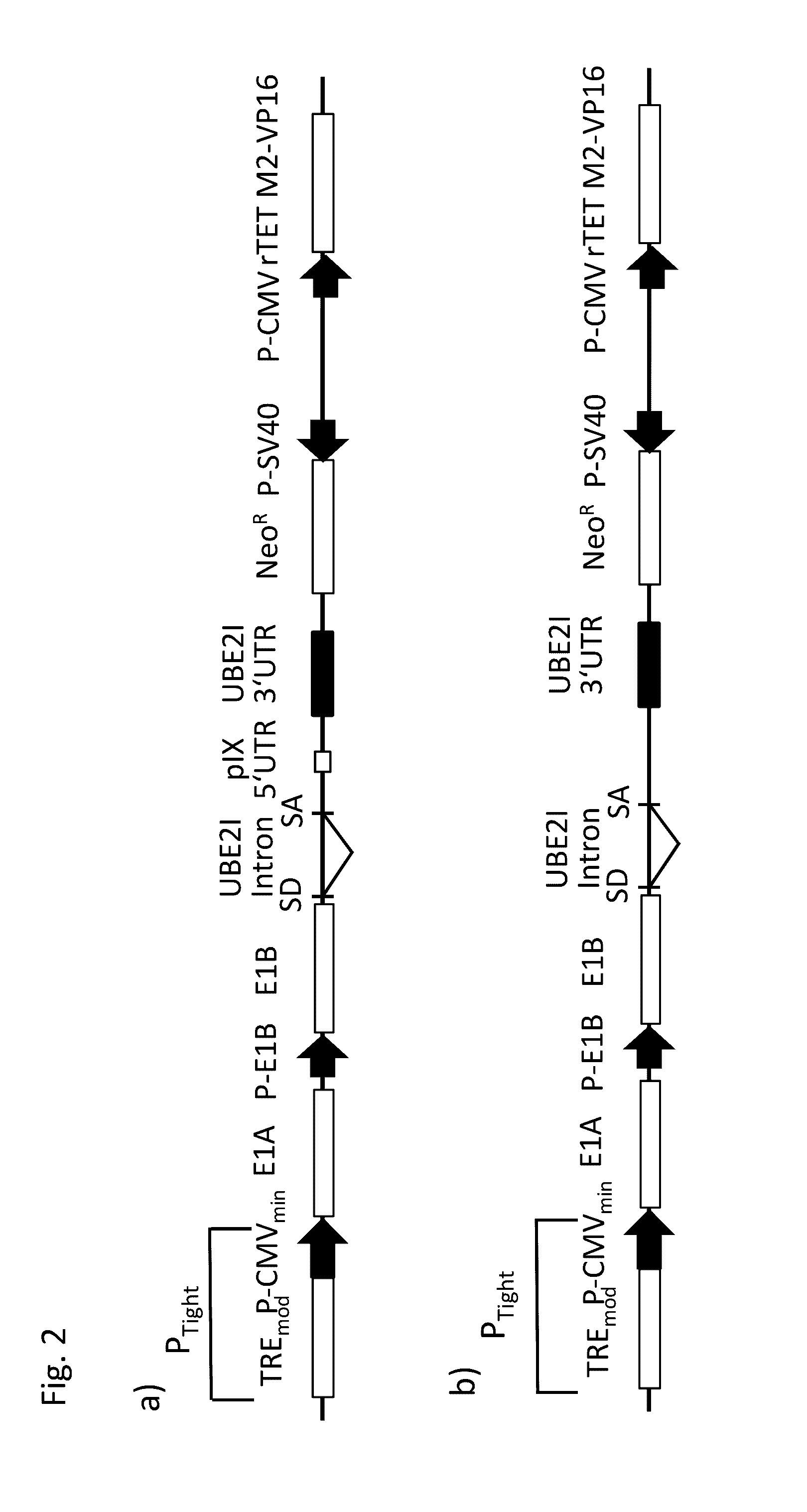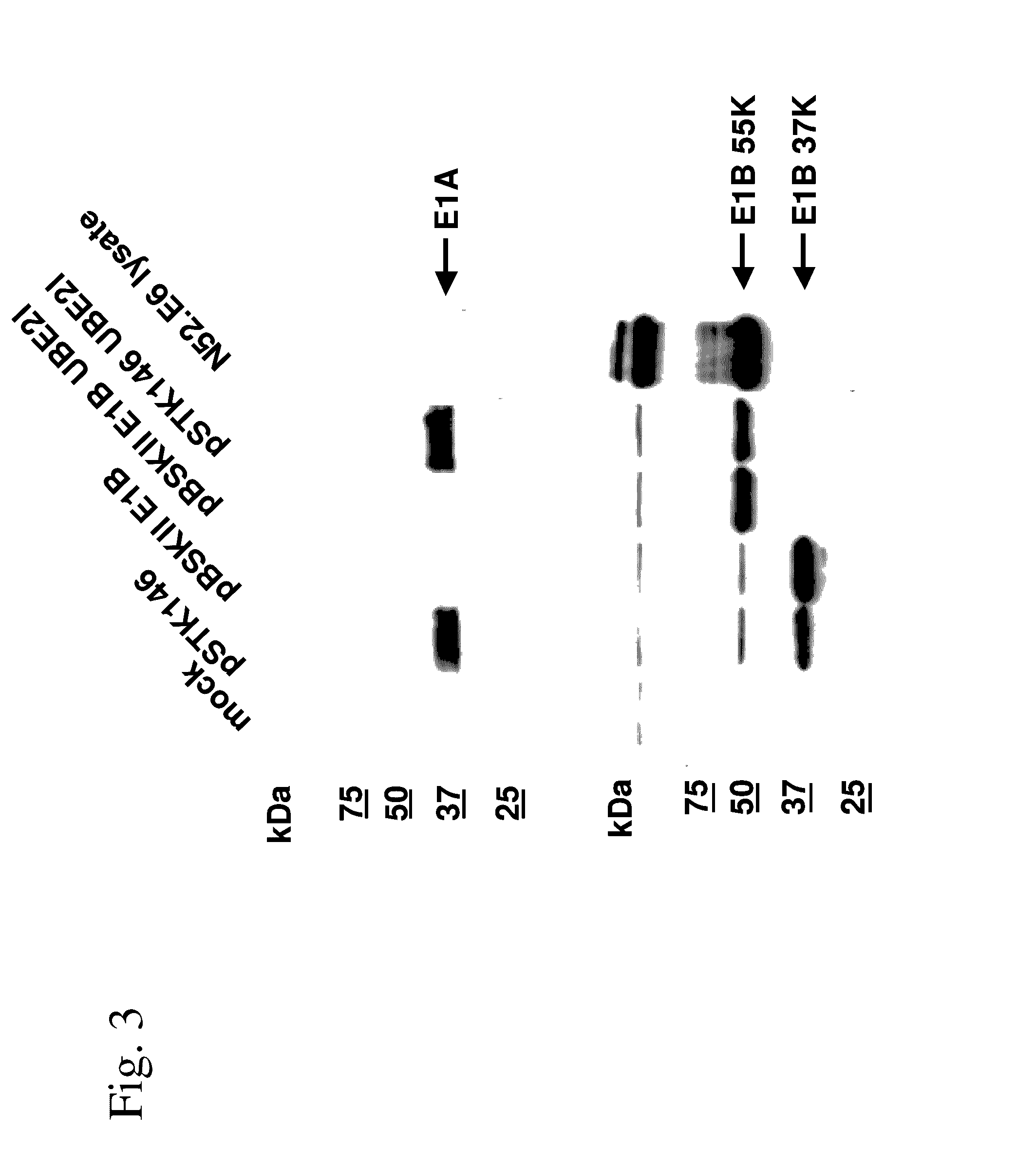Nucleic acid construct and use of the same
a technology of nucleic acid and construct, which is applied in the direction of biochemistry apparatus and processes, viruses/bacteriophages, dsdna viruses, etc., can solve the problems of not being suitable for production of clinical grade materials, frequent occurrence that cannot be controlled or avoided, and notoriously difficult to transform primary human cells
- Summary
- Abstract
- Description
- Claims
- Application Information
AI Technical Summary
Benefits of technology
Problems solved by technology
Method used
Image
Examples
example 1
Cloning of the Ad5 E1 Expressing Construct pSTK146UBE2I
Cloning Strategy
[0260]According to previous results human primary amniocytes can be transformed by E1 proteins of hAd5 (Schiedner et al., 2000). The E1 expressing construct pSTK146 of the prior art used in these experiments contains non-coding SV40 sequence elements including intron and 3′ UTR that are often found in many transcription cassettes enhancing gene expression. An intron at the 3′ end of the E1B 55K coding sequence including a splice acceptor is necessary for splicing of the MB mRNAs and efficient expression of E1B 55K protein. An embodiment of the nucleic acid construct of the present invention which his referred to herein as pSTK146 UBE2I, was generated, replacing the SV40 intron and 3′ UTR by a short intron, including splice donor and splice acceptor and a 3′ UTR of the human gene UBE2I (NCBI Reference Sequence: NT_010393.16, SEQ IC NO: 25. Additionally, a short sequence of the pIX gene was inserted which allows fo...
example 2
Western Blot Analysis to Detect Steady-State Levels of E1 Proteins
[0262]To determine expression levels of the E1B 55K protein after transient transfection using various E1B 55K expressing nucleic acid constructs 1×106 Hela cells were seeded in 6 cm dishes. The next day the cells were washed with phosphate-buffered saline (PBS) and fresh medium was added. The cells were transfected with 3 μg of plasmid pSTK146 (expressing both E1A and E1B) and plasmid pBSKII E1B (expressing only E1B from the natural E1B promoter), pBSKII E1B UBE2I (expressing E1B from the natural E1B promoter and containing the UBE2I elements) and plasmid pSTK146 UBE2I using polyethylenimine (PEI) as transfection reagent. After 48 hours the cells were washed with PBS, detached with 50 mM EDTA in PBS and pelleted by centrifugation. Cell pellets were lysed with 200 μl RIPA lysis buffer (40 mM Tris / HCL, pH 8, 150 mM NaCl, 5 mM EDTA, 1% (v / v) Nonidet P-40, 0.1% (w / v) SDS, 0.5% (w / v) sodium desoxycholate) for 30 minutes o...
example 3
Determination of Aberrant Splicing of E1B mRNA Transcripts in pSTK146-Transfected Cells
[0264]Western blot analysis of pSTK146-transfected cells by the N-terminal binding E1B-specific antibody 2A6 showed—in addition to E1B 55K—a faster migrating E1B protein named E1B 37K. To test at the mRNA level, if the E1B 37K protein resulted from aberrant splicing events, total RNA from pSTK146-transfected Hela cells was extracted with Trizol Reagent and further purified using Phase Lock Gel tubes (PLG, Eppendorf) and RNeasy Mini Kit (Qiagen) including DNAse treatment according to the manufacturers' instructions. Complementary DNA (cDNA) was synthesised with the SuperScript™ III First-Strand Synthesis System (Invitrogen, Carlsbad, USA) as described by manufacturer's protocol and RNA was reverse transcribed using an oligo-dT primer. PCR amplification of cDNA was performed with Taq Polymerase (NEB) using the forward oligonudeoxycleotide #59 (5′-CTGAACTGTATCCAGAACTGAG-3′(SEQ ID NO: 30)), which bind...
PUM
| Property | Measurement | Unit |
|---|---|---|
| molecular weight | aaaaa | aaaaa |
| concentration | aaaaa | aaaaa |
| concentration | aaaaa | aaaaa |
Abstract
Description
Claims
Application Information
 Login to View More
Login to View More - R&D
- Intellectual Property
- Life Sciences
- Materials
- Tech Scout
- Unparalleled Data Quality
- Higher Quality Content
- 60% Fewer Hallucinations
Browse by: Latest US Patents, China's latest patents, Technical Efficacy Thesaurus, Application Domain, Technology Topic, Popular Technical Reports.
© 2025 PatSnap. All rights reserved.Legal|Privacy policy|Modern Slavery Act Transparency Statement|Sitemap|About US| Contact US: help@patsnap.com



